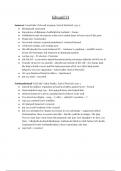Edward VI
Somerset ‘Good Duke’ (Edward Seymour, Earl of Hertford) 1547-9
● Ideologically motivated
● Experience of diplomacy/battlefield in Scotland + France
● Established court of requests at his own London home to hear cases of the poor
● Progressive social policy
● Prevented extreme corporal punishment -tortured/burned
● Criticised wealthy, self-seeking men
● H8 will intended to create balanced PC - Gardener’s expulsion + norfolk’s arrest =
favour of Protestants, left Somerest in dominant position
● 31st Jan 1547 - PC elected - Protector
● 4th Feb Ed + 13 executors signed document giving sovereign authority util Ed was 18
● Transfer of power was smooth - already had custody of the will + dry stamp, kept
the King’s death a secret until he had possession of Ed, new titles/land grants
helped to win over opposition = John Dudley (Earl of Warwick)
● Oct 1479 dismissed from his offices + imprisoned
● Jan 1552 tried + executed
Northumberland ‘Evil Duke’ ( John Dudley, Earl of Warwick) 1550-3
● Earned his military reputation in land/sea battles against Scots + French
● Masterminded coup 1549 - then purged those who helped him
● Ordered Somerset’s arrest, manufactured evidence in the trail
● Two-faced on religion - coup = C, after = radical P, execution = C
● Aug 1549 crushed Kett’s rebellion
● Oct planned Somerset’s removal
● Jan 1550 Lord President of the Council
● July 1553 attempted to change succession to own advantage - supported radical
Protestantism, Mary accession ruin this + his life would be in danger. The plan
‘Devyse’ (may have come from Ed) proposed Lady Jane Grey (daughter-in-law), 1553
Mary + Elizabeth declared illegitimate. Parliament failed to ratify before Ed’s death.
Unprepared it took Northumberland 3 days to proclaim Lady Jane
● Aug tried + executed
, Religion
Somerset
1. Late convert to Protestantism, policy was cautious, evidenced by the moderate Book
of Common Prayer 1549 (Cranmer) anxious to avoid religious tension. Influenced by
his wife Anne Stanhope, who was widely recognised as a woman of radical religious
views, he was thought to have abandoned Mass in his household by 1547
2. Welcomed religious radicals ( John Hooper, Thomas Becon) into his household,
although, was not completely generous to reformers who filled to England to escape
prosecution of Emperor Charles V, they were dependant on Cranmer and Edward
3. Nicholas Ridley - Cambridge educated reformer, Bishop of Rochester and London
4. 1547 Denunciation of images in London - reflected radical attitudes among
churchmen (Ridley), activists support engaged in widespread iconoclasm
5. 1547 Royal visitations – Commissioners sent to all bishoprics to examine the state of
the clergy and what doctrines and practises were being pursued
6. Book of Homilies and Paraphrases – Served 2 purposes, to educate both the laity
and clergy in the new doctrines and fill in the gap in preaching created by reform. A
collection of sermons (some written by Cranmer) to be placed in every church.
Asserted belief of justification of faith alone, repealed Catholic belief in salvation by
faith and good works.
7. 1547 Royal injunctions - Instructed celery to perform services in English and hold
services every Sunday. Reflected radical attitudes within government, attacked
features of Catholicism - lights, images, stained glass, processions and practises
associated with Candlemas, Ash Wednesday and Palm Sunday. Introduced a new
litany which would be sund kneeling.
8. 1547 Act for the giving of chantries, colleges and religious guilds to the king – Crown
needed money for foreign policy for Scottish wars and the Privy Council stated
dissolution was primarily to relive the kings expenses - chantries (approx 3000),
guilds, lay brotherhoods abolished and property seized, many bishops and their
cathedrals were raided (Lincoln lost 30 manors, Bath/ Wells 20, Norwich 12, Exeter
9) condemned prayers for the dead. Somerset’s interest in education, dissolution of
chantries to put in place grammar schools, in reality, most of the money went into
the coffers of the Crown
9. Act of Six Articles Repealed – Originally had re-established Catholic doctrines, now
the church was left without official doctrine.
10. Treason act Repealed – Removed heresy, treason, censorship and proclamation
laws, allowed people to discuss religion freely – opportunity for radicals to spread
views, destroy Catholic images/alters, and attack the Mass.
11. 1548 Series of Proclamations - Dampen protestant unrest, Privy Council felt the
need to assert that transubstantiation was in force and Catholic rites needed to be
adhered to.
12. 1548 All Images Removed from Churches – Little opposition




